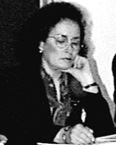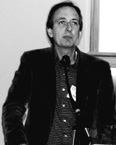A PRIMER FOR SCIENTISTS
There may not be a bare lightbulb swaying at eye level, nor the requisite instruments of torture to reward inadequate answers, but biomedical researchers with findings deemed of interest to the public should expect the third degree-at least from any reporter who's been schooled in the art of interview by veteran science writer Vic Cohn, formerly of the Washington Post and a visiting fellow at the Harvard School of Public Health.
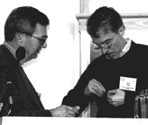 Reminiscences: Two former directors, NCI's Vince DeVita and NINDS's Zach Hall shared a mike and tales of relations with the press and advocacy groups during their NIH stints. |
Sounding as no-nonsense as Sergeant Joe Friday asking for "just the facts, ma'am," Cohn hammered out the questions any reporter aiming for the real story should ask any scientist purporting to have one. "How do you know?" "What are your numbers?""How did you get them?" "How valid, reliable, reproducible are your data?" "Are there any flaws in your work?" "What is your degree of certainty?" "Who disagrees with you and why?"
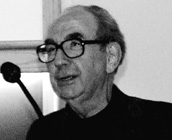
|
These questions, Cohn said, are no reflection on the legitimacy of the research or the researcher but basic tools of medical journalism that must be applied equally to all research-whether obscure or famous, controversial or acclaimed-and to alternative as well as conventional therapeutic strategies.
And how should a researcher respond to these questions? Simply put: "Honest people will answer honestly," Cohn said. As a rule of thumb, "any honest researcher will admit a degree of uncertainty," he maintained, adding that it is "the certainty of uncertainty" that, if acknowledged, will preempt the fiasco of tomorrow's headline toppling today's medical breakthrough and undermining the credibility of public health messages. (But scientists can also be pilloried for "uncertainty", according to NCI's Barbara Rimer; see story, page 8.)

|
Cohn advised reporters to beware of "artful dodgers." When researchers offer conflicting findings or interpretations, a reporter ought to view with more skepticism anyone who dodges questions. Similarly, small numbers, findings that have not been replicated, and "anecdotes and miracles" should give reporters pause, he said. "Have results been repeated among different populations? Are they supported by animal or other biological evidence? Is there a hint of bias or conflict of interest?" These are all legitimate and necessary lines of inquiry, said Cohn, whose manual News & Numbers: A Guide to Reporting is in its sixth printing and used in journalism schools around the country.
He also posited a hierarchy among clinical research studies, with randomized, controlled clinical trials offering the best hope of valid results. Several scientists, however, including Robert Young, president of the Fox Chase Cancer Center in Philadelphia, were quick to cite transforming medical findings that had emanated from research that did not reach this "gold standard."
Young also cautioned against overappreciating highly statistically significant results: "A great p-value can sometimes signify a statistical benefit that exceeds any biological benefit."

|
Marcia Angell, coeditor of the New England Journal of Medicine, agreed that "P-values are no substitute for common sense." Statistics, she observed, can be reported in different ways that are mathematically correct but impart different meanings. For instance, a 1 percent difference in survival (93 percent vs. 94 percent) in a controlled clinical trial comparing streptokinase to tPA in the treatment of myocardial infarction could also be reported as a 14 percent reduction in mortality with tPA over streptokinase if the 6 percent and 7 percent mortality rates, respectively, are compared, she noted. Angell and Young concurred with the journalists in attendance that when scientists communicate with the press and public, they need to put statistical findings in a context that conveys their biological significance and health impact.

|
Otis Brawley, director of the NCI Office of Special Populations Research, cautioned reporters, however, to pay close attention to the interests of the individual relaying the findings. He pointed to an Associated Press story carried in newspapers all over the country that led to a marked temporary decline in accrual in, and increased dropouts from, a major prostate cancer prevention trial of the 5alpha-reductase inhibitor Proscar vs. placebo. In reporting the findings of another study comparing Proscar, Hytrin (an alpha-blocking antihypertension agent), and placebo in the treatment of benign prostatic hypertrophy, the reporter quoted a urologist who extolled the advantages of Hytrin over Proscar. The urologist's financial interests in Hytrin were not mentioned, nor was the fact that Hytrin's effectiveness varied with prostate size. Proscar was portrayed as no better than placebo in a condition involving the prostate gland. "That story did significant harm; the context was wrong," Brawley said.
He challenged scientists to meet their "professional responsibility-to talk to the media more," especially to correct misconceptions. A leading misconception-generated by the use of young women in mammography posters and the publicity about screening between ages 40 and 49-is that the "average breast cancer patient is 44 years old, instead of 68." Prostate cancer, too, has areas of distortion. "Early detection has become a religion, but with prostate cancer screening, we're raising hopes unjustifiably," Brawley said, citing unchanged postdiagnosis survival rates: 72.7 months in 1972 and, despite increased screening, 72.4 months in 1994.
Researchers are not the only ones who may bend the truth in the direction of self-interest, Brawley added-so may patient advocacy groups. He relayed an incident in 1997: A prostate cancer advocacy group actually attempted to stop the American Cancer Society from publishing a downward correction of its numbers of projected prostate cancer cases from 344,000 to 209,900.
War Stories
Similar manipulations plagued Zach Hall, who recently left NIH after three years as the director of NINDS and is now associate dean for research and Lange professor of physiology at UCSF. "I was least prepared for advocacy groups, Congress, and funding issues, primarily around Parkinson's disease," Hall said of his tenure at NIH. One of the incidents he found most astounding involved the request of an advocacy group that NIH forgo its intended release to the press of data showing advances against a particular disease. To mount a campaign for more money, "they needed to de-emphasize success, and they typically inflated patient numbers by a factor of two," he said of some advocacy groups. They also wanted NINDS to support only clinical trials, not basic research.
Former (1980-1988) NCI director Vincent DeVita, now director of the Yale Cancer Center in New Haven, Conn., and professor of medicine and of epidemiology and public health, faulted both "loose-lipped scientists and the desire of reporters for the front page" for overblown headlines and misleading medical news. But DeVita was one of the few people at the conference who defended the "War on Cancer" and castigated the press for dealing with it unfairly when its accomplishments appeared to fall short of its vaunted promise.
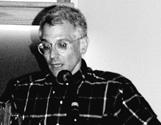
|
The War on Cancer served as the conference's prime example of media hype that backfired, leaving a legacy of unmet goals and public disillusionment.
"Launched with hyperbole" in 1971 with the signing of the National Cancer Act by President Richard Nixon, the War on Cancer was "meant to distract the public from the war in Vietnam," said Eric Rosenthal, conference cochair and director of public affairs at the Fox Chase Cancer Center. "Cancer was an enemy the nation could defeat in the age of Vietnam," he observed, and the "war" against it could capture headlines and news magazine cover stories that proclaimed the victories of the Nixon administration in biomedicine, diverting attention from the body count in the real war. For instance, the words "New Gains in War on Cancer" filled the cover of a Vietnam era issue of U.S. News and World Report save for "Vietnam Showdown" boxed in a corner.
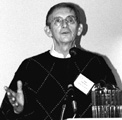
|
But the media eventually cloaked both wars in failure, using body count as the benchmark in the cancer war as well. This narrow approach, DeVita charged, undervalued advances that prolonged and improved quality of life. He credited the War on Cancer and the additional money it brought to cancer research with the development of hybridomas, monoclonal antibodies, biologics, radiolabeled antibodies, and antiangiogenesis
approaches. And the scientific yield of the Cancer Virus Program, the first initiative of the War on Cancer, which the media also panned, included discovery of restriction enzymes, reverse transcriptase, the oncogene cascade, and cancer genetics, to name a few. Moreover, he said, even the body count has begun to decline.
It was during his tour of duty as NCI director, DeVita recalled, that he "learned how to deal" with the public and the press. "I was taught by my public affairs officer," Paul Van Nevel, NCI's associate director for cancer communications. "'Be honest,' he told me."
Seeking an Unhypey Medium:Although reporters and science writers of the popular press may overstate research findings, they are educable," Boston Globe science writer Richard Saltus assured the scientists gathered at Cold Spring Harbor. But they're under pressure to make the strongest statements possible because if their stories aren't placed on page one, they get lost," especially if they have to compete with political scandals to make the front page, Saltus said. Another reason for hype, offered by veteran health reporter Cristine Russell of the Washington Post, is that "scientists have PR firms. They vie for attention. It's business now." The commercial aspects of biomedical research have contributed also to the flip side of hype: hiding information, Saltus added: "We've seen sponsors try to gag negative stories."
And, Russell added, sometimes scientists-if they're concerned that an issue is too complex, controversial, or new to bear press exposure-try to bar reporters from access to information that would actually improve understanding and accuracy. For instance, the Asilomar meeting on then-emerging recombinant DNA techniques was initially closed to the press; 12 journalists, she among them, clawed their way in. The result was superior reporting on a topic fraught with panic potential, she said. Saltus agreed that the more complicated the research, the wiser an open door policy (see also "The Press Meets NIH," page 1). -F.P. |
